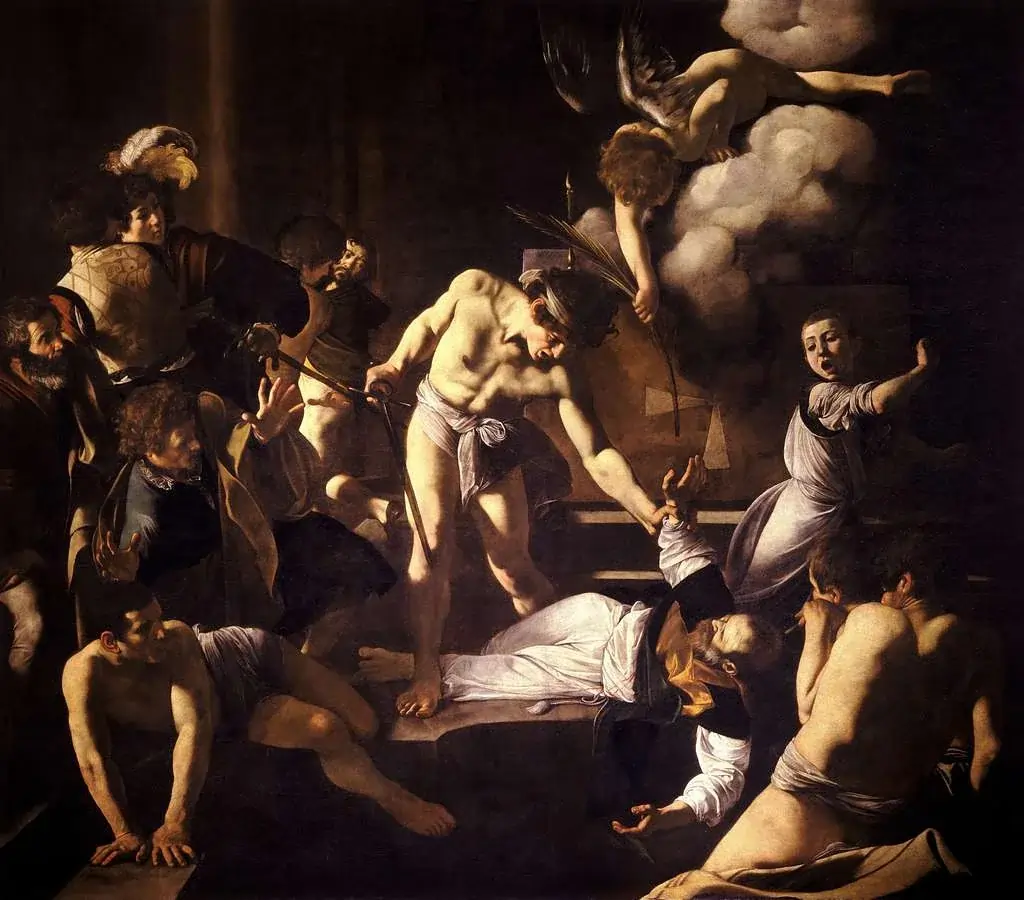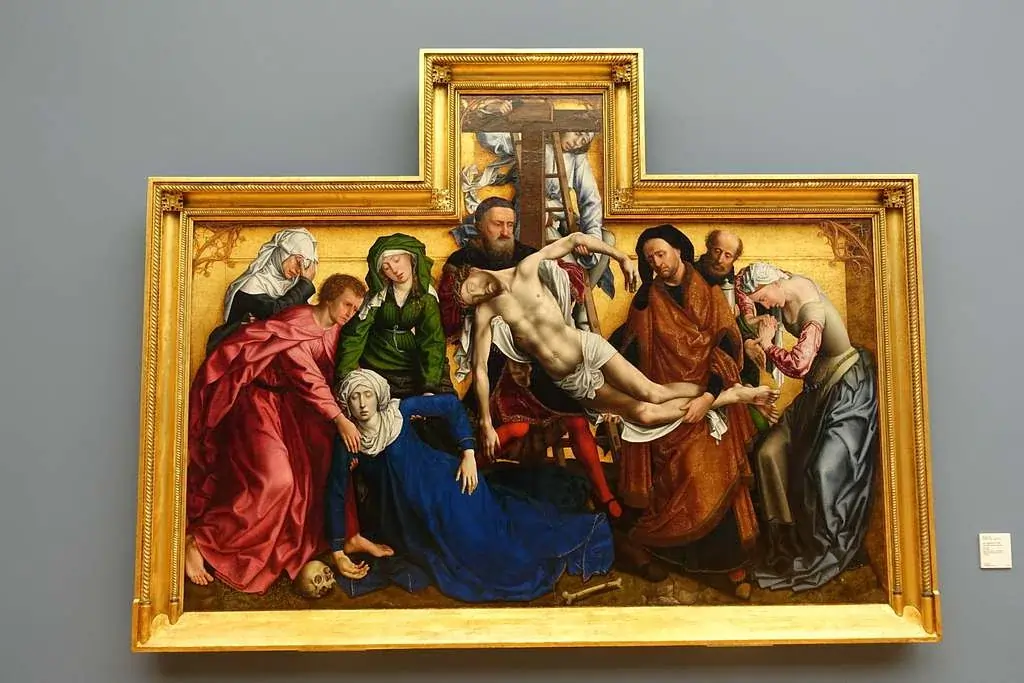In art history stands a gripping scene where a saint falls beneath a raised sword amidst intervention frozen in time. It’s known as The Martyrdom of Saint Matthew – a truly dramatic depiction.
We are captivated by Caravaggio’s artwork that intertwines violence and spirituality, within a cathedral backdrop in his iconic painting crafted in 1600 for the Contarelli Chapel. It signifies not just the passing of a saint but also embodies a significant shift in religious art history due to Caravaggio’s skillful manipulation of light and darkness that captures a transformative instant shaping the future of artistic expression, with strong spiritual undertones.
Let’s delve into the background and creative advancements along, with the subtle meanings hidden within The Martyrdom of Saint Matthew. A pivotal piece, in Baroque art history that defied conventions and carried intricate religious messages through its innovative techniques and timeless beauty.
Table of Contents
ToggleThe Historical Context behind the Masterpiece
Let’s take a trip back, to Rome in the century and delve into the beginnings of Caravaggio’s iconic creation at the lively San Luigi dei Francesci church scene. Cardinal Matthieu Coiterel (known as Contarelli, in Italian) acquired a chapel in 1565 which would eventually become home to this groundbreaking masterpiece.
The Contarelli Chapel Commission
The paintings creation can be linked back, to July 23rd in the year 1599 when Caravaggio was given a project by his supporter Cardinal del Monte It was quite a challenge, for Caravaggio as he had never tackled such a sizable canvas or worked with so many figures before.
Saint Matthew's Life and Martyrdom
The intense moment portrays the instance of Matthews’s life inspired by beliefs and teachings; we witness the saint being attacked as he officiates Mass at the altar and ultimately killed based on the Ethiopian monarch’s commandment. The narrative recounts that Matthew incurred the king’s displeasure by admonishing him for desiring his niece who was a nun.
Religious Art in Counter-Reformation Rome
During the Counter Reformation era, in history we are witnessing a shift, in art. The Catholic Church laid out rules during the Council of Trent (1545–1563) regarding the creation of art pieces;
- Artwork must inspire piety and faith
- Images should be relatable to ordinary people
- Extreme emotions should be depicted to forge psychological connections with viewers
This painting represents a significant shift that occurred in the art world where the intellectual Mannerist style of the earlier paintings was replaced by the emotional Baroque period. In contrast to his fellow artists who tended to depict martyrdom as rapturous events, Caravaggio offered a contrasting vision which forced me to confront the real suffering of the saint in his last moments.
Caravaggio's Revolutionary Artistic Choices
Looking at The Martyrdom of Saint Matthew, we find one of the most important changes in the art history. Going through Caravaggio’s decisions in this work, we are able to see how he changed the face of religious painting forever.
Breaking Traditional Religious Art Conventions
Caravaggio’s brilliance is evident in his departure from the traditional depictions of religious figures. In contrast to the Renaissance practice, he posed the models himself and painted without any idealization of the subject. He subverted the traditional approach by presenting the biblical characters as they were; fallible, imperfect and very much human.
The Power of Chiaroscuro Technique
The painting stands out for Caravaggio’s application of chiaroscuro and tenebrism techniques that bring a sense of drama and depth to his work.
- Sharp contrasts between light and dark areas
- Focused illumination from a high source
- Three-dimensional depth through selective lighting
- Dramatic spotlighting of key figures
Dramatic Composition and Movement
Caravaggio’s art captivates us with his decisions that bring the figures close, to the forefront of the painting canvas and establish a direct bond with those observing it. The artwork depicts a moment described by his biographer as being full of drama and frozen in time as if captured in a flash of lightning. The chaotic motion is harmoniously offset by the elements like steps and altars while the vertical architectural features lend a sense of steadiness, to the setting.
Caravaggio’s striking theatrical presentation intensifies the drama. The ethereal figures emerge from the shadows in a way that would have felt like an expansion of the chapel’s space, to viewers at the time. This fresh take on arrangement transports us to witness this crucial moment, in religious history.
Symbolic Elements and Religious Messaging
Upon examination of Caravaggio’s artwork we uncover a complex web of religious imagery that turns this intense scenario into a deep contemplation, on belief and redemption.
The Angel's Divine Intervention
Looking at the painting, we see that the angel presents a remarkable analogy: while the executioner’s sword slashes in violence, the angel holds a palm branch of martyrdom. What is even more interesting is the fact that only Matthew meets the divine messenger, which gives this scene not only the aspect of terror, but the aspect of a personal encounter with the divine. The angel’s gesture turns what could have been a moment of fear into a moment of triumph from a spiritual point of view.
Baptismal Imagery and Redemption
The strong symbolism of baptism that runs through the scene captures our attention deeply. The baptismal font isn’t there, for show; it makes a theological statement about the concept of death and rebirth. The blending of Matthews’s blood, with the water forms a visual metaphor that links us to profound Christian ideals;
- The unity of martyrdom and baptism
- Death of the old self and spiritual rebirth
- The cleansing power of sacrifice
Hidden Christian Symbolism
When we delve into the aspects of the paintings essence we come across some symbolic nuances. The lone flickering candle, atop the altar symbolizes Gods all-knowing gaze bearing witness to the martyr’s act of sacrifice. The presence of the cross evokes the spirit of warriors while the alignment of lines drawn by the executioners hand and the angel’s outstretched arm gently guides our gaze through this divine spectacle. Together these elements harmonize to transcend a depiction of history transforming it into contemplation, on matters of faith and selfless devotion.
The Human Drama Unveiled
As we gaze at the expressions, on the faces of Caravaggio’s figures in The Martyrdom of Saint Matthew painting we are met with a portrayal of emotions and inner thoughts. The painter’s skill in depicting responses elevates this religious depiction into a deep dive, into the essence of mankind.
Character Studies and Emotional Responses
We observe a remarkable range of emotional responses among the witnesses to Matthew’s martyrdom. The characters display varying degrees of horror and reaction:
- The altar boy’s face contorts in a visceral scream of terror
- The old woman clasps her head in horror, serving as the emotional anchor
- Several figures attempt to flee while unable to tear their eyes from the scene
The Psychology of Violence
When we delve into the heart of the paintings intensity we can observe Caravaggio’s method of capturing martyrdom. In contrast, to his peers who frequently depicted martyrdom as instances of happiness or euphoria we witness an honest depiction of brutality. It appears that the artists own encounters with violence shaped his creations. His reputation for a temper and had numerous encounters with the law.
Caravaggio's Self-Portrait as Witness
It’s quite fascinating how Caravaggio chose to depict himself in the painting. I noticed his self-portrait in the background, towards the center, behind the assassin. His expression is quite revealing. He seems puzzled. Seems to empathize with those running away in shame. This decision to include him gives us viewers a perspective. Makes us feel like we are also part of this sorrowful scene.
Caravaggio’s artistic portrayal shifts a religious story, into a tale that blends divine intervention, with mortal emotions of fear and bravery. His innovative depiction of authenticity evokes the sensation of being immersed in a moment of history rather than merely observing it.
Conclusion
Caravaggio’s painting depicting the Martyrdom of Saint Matthew showcases both bravery and spiritual commitment in a way. By playing with light and darkness and capturing emotions, with rich symbolic details the artwork transcends its biblical origins to offer a timeless depiction of human struggle and emotion that captivates audiences even today.
This exceptional artwork pushed the boundaries of norms during its era. Also met the requirements of the Counter Reformation, for relatable religious artistry. The brilliance of this painting is in its capacity to blend interpretations together seamlessly. Where conflict intersects with divine guidance; mortal apprehension clashes, with spiritual victory; and worldly theatrics evolve into everlasting redemption.
Caravaggio’s unique contribution lies in his ability to immerse himself among the observers and engage us as participants, than mere spectators, in his work of artistry and storytelling that resonates deeply with our human sensibilities and emotions.
The story of Saint Matthews sacrifice serves as an example of how timeless art can reflect themes of belief and humanity that endure through generations.
FAQs
Q1. What makes Caravaggio’s “The Martyrdom of Saint Matthew” revolutionary? Caravaggio’s painting broke traditional religious art conventions by using chiaroscuro technique, dramatic composition, and portraying biblical characters as ordinary people. This approach created a more relatable and emotionally charged depiction of religious scenes.
Q2. How does the painting reflect the Counter-Reformation’s influence on religious art? The painting aligns with Counter-Reformation guidelines by inspiring piety, depicting relatable figures, and showcasing extreme emotions. It marks a shift from the intellectual Mannerist style to the more emotionally charged Baroque period.
Q3. What symbolic elements are present in the painting? The painting includes several symbolic elements such as the angel offering a palm branch of martyrdom, baptismal imagery representing redemption, and a burning candle symbolizing God’s presence. These elements add layers of religious meaning to the scene.
Q4. How does Caravaggio portray human emotions in the painting? Caravaggio masterfully captures a range of human emotions through the characters’ reactions to the violent scene. From the altar boy’s scream to the old woman’s horror, the painting presents a study in authentic human responses to tragedy.
Q5. Why did Caravaggio include a self-portrait in the painting? Caravaggio included himself as a witness in the background, appearing perplexed. This self-inclusion makes viewers feel like participants in the scene, blurring the line between art and reality, and adding a personal dimension to the religious narrative.



